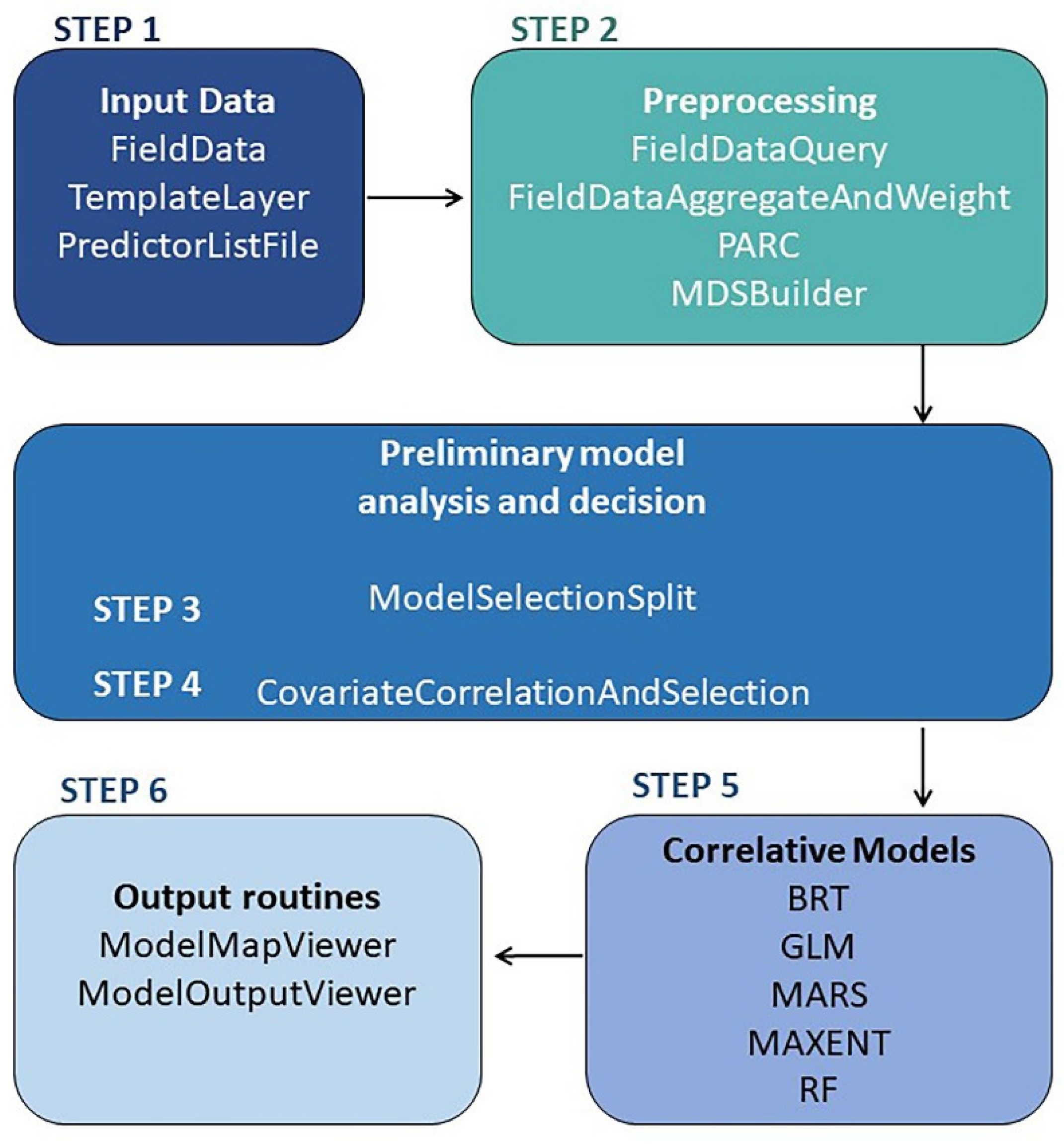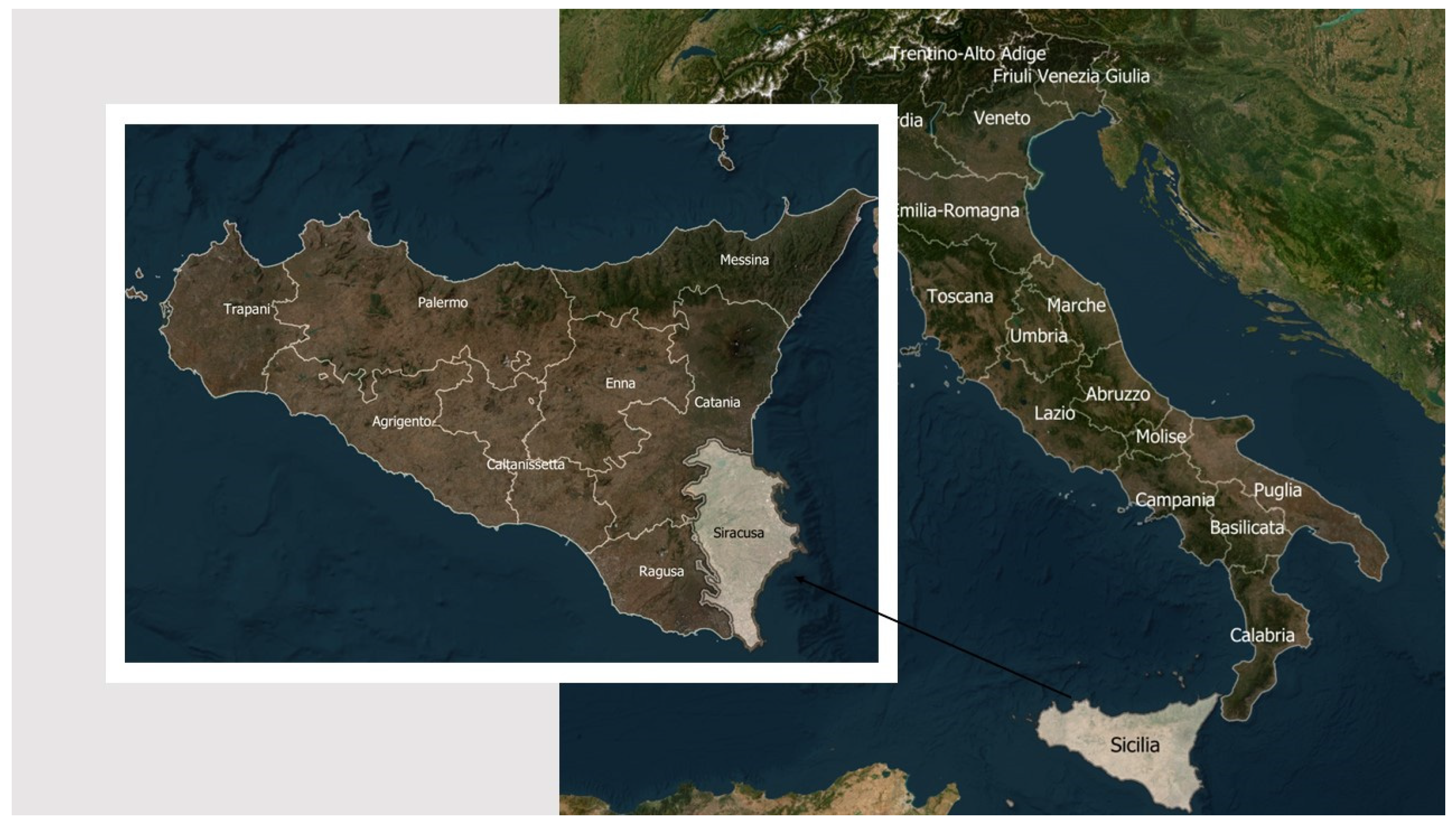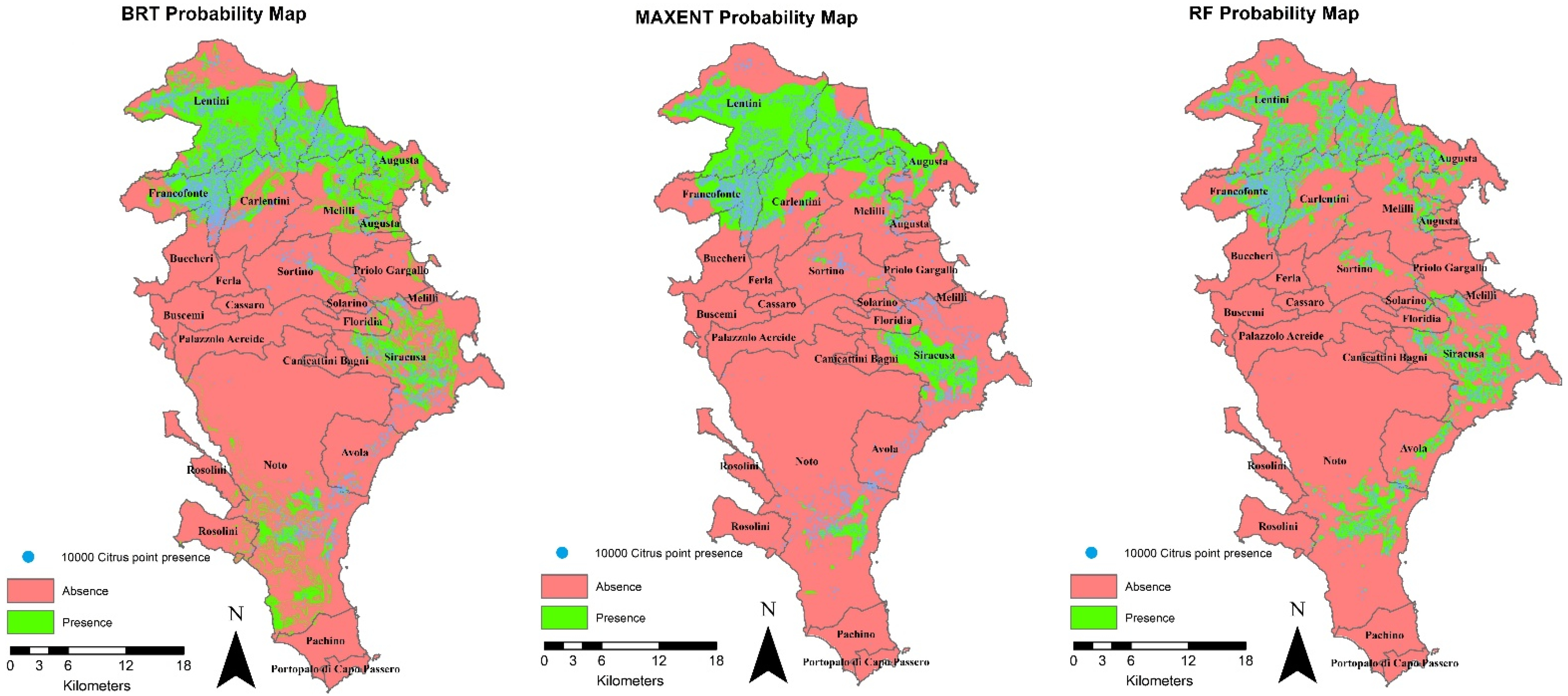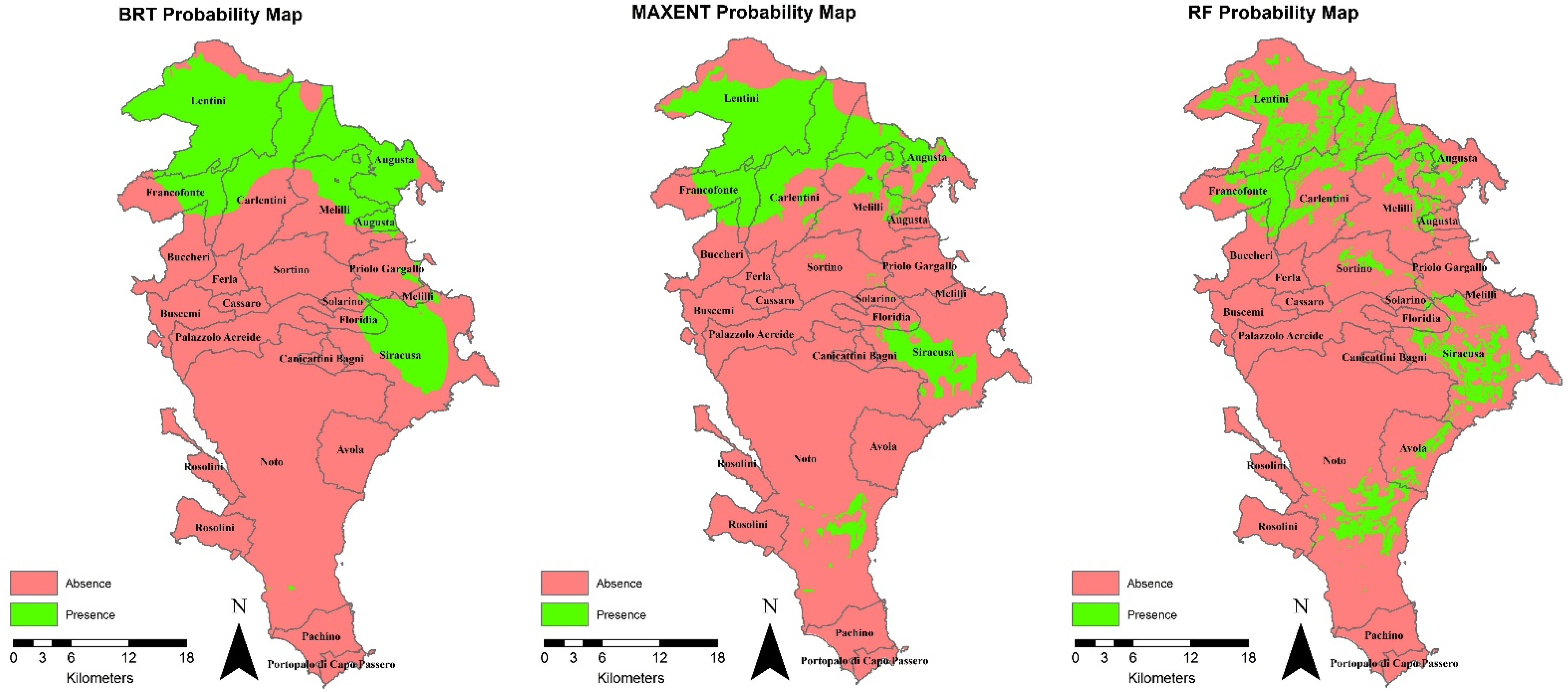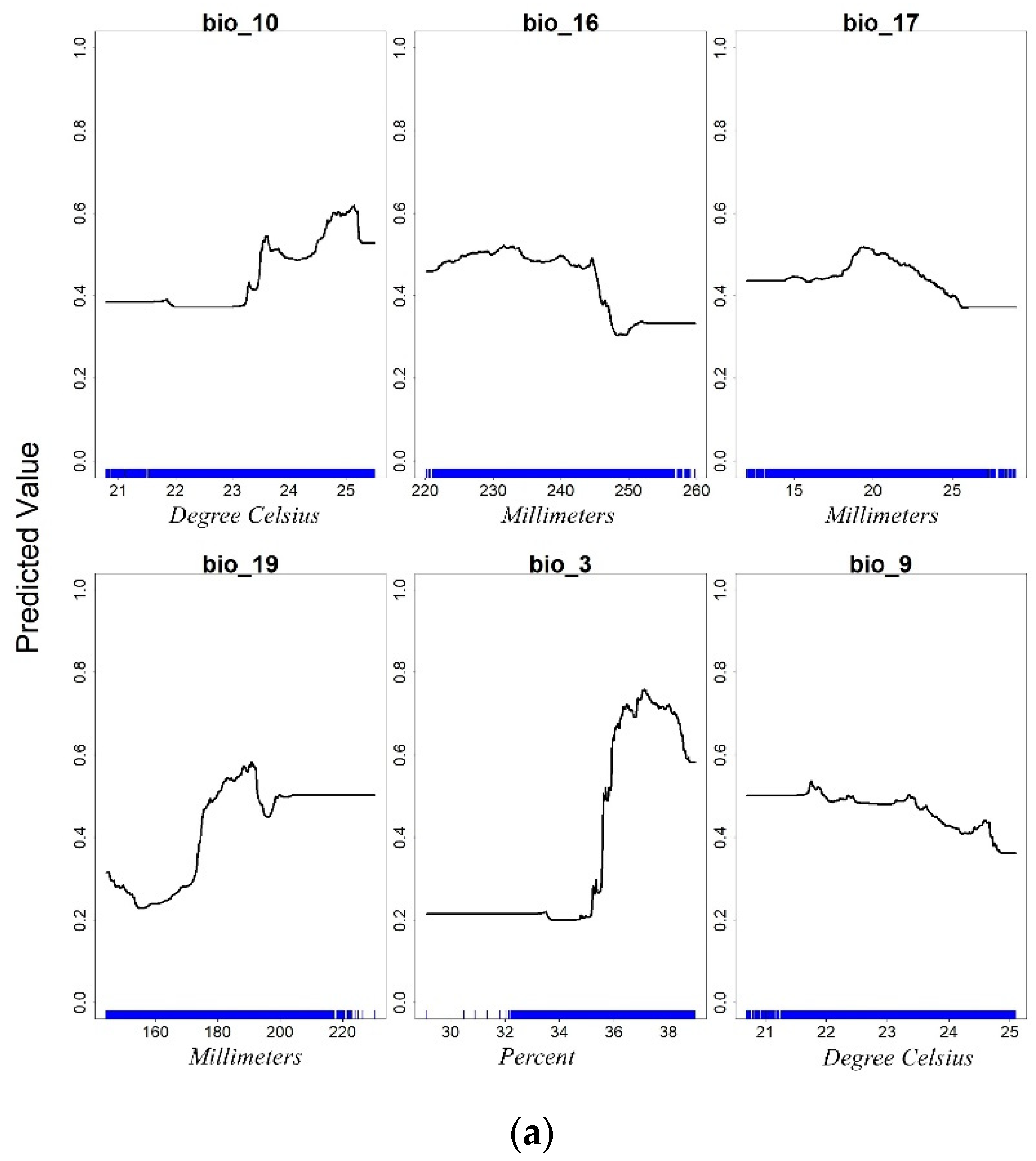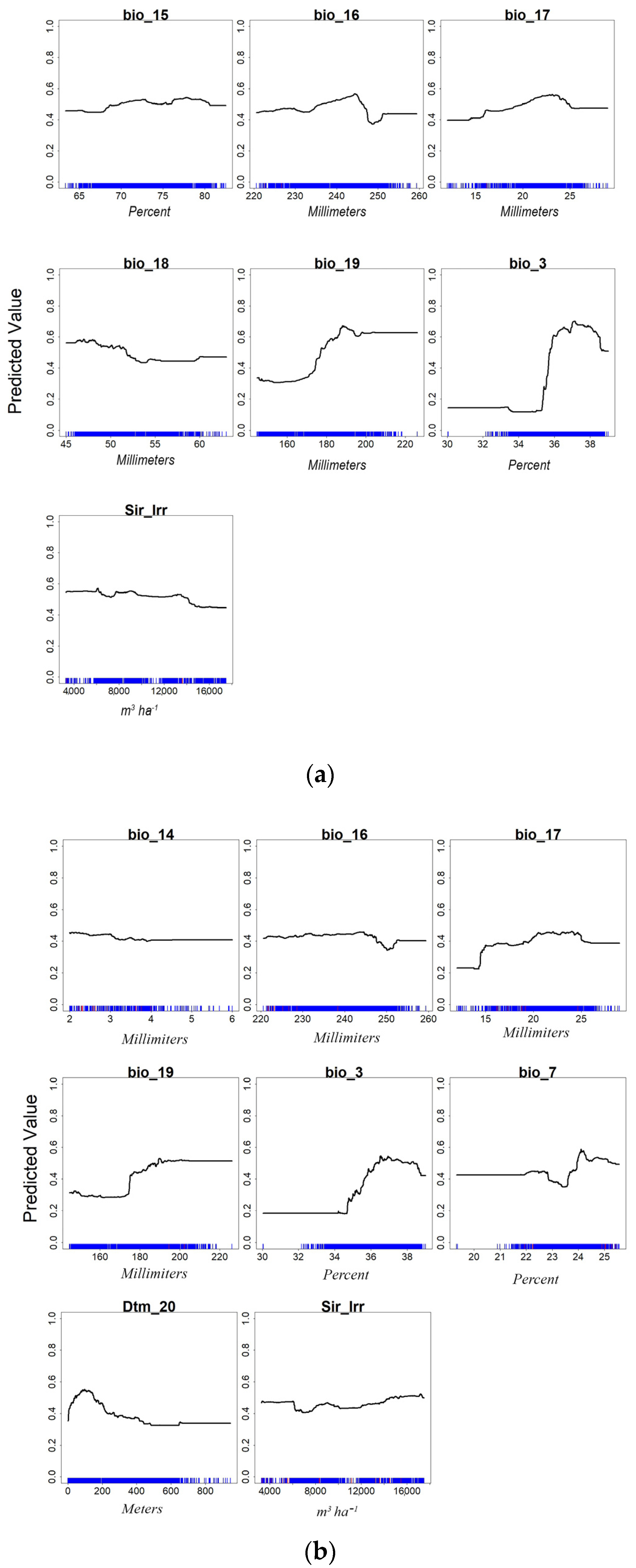3.1. Fine-Tuning Models’ Parameters
The execution of the five different algorithms was carried out by using the values of the models’ parameters described in
Section 2.3. Specific sensitivity analyses were performed by modifying the default values of the parameters one at a time and keeping the others at their default values. This analysis, based on refined parameters, was compared with that performed by using default parameters and model autoregulation, obtained in a previous study [
19], the main results of which are reported in
Figure 3 and
Table 3 (and
Supplementary Materials, Figure S1) to facilitate the comparison with the outcomes of this study.
The analysis based on refined parameters produced the results reported in
Figure 4 and
Table 4.
The ΔAUC value for BRT improved, showing a reduction in overfitting, while the other accuracy measures decreased, though they were still above the threshold of fair prediction accuracy. However, this simulation by BRT was incoherent from the point of view of the citrus species distribution in the territory due to the absence of the species in the southern area of the province and a general increase in less detailed predicted areas for the species (i.e., more uniform areas without holes).
Moreover, from the sensitivity analyses performed, in relation to increments of LR from 0.001 to 0.1, predicted areas for the species decreased to the point of determining no presence in some areas, and corresponding ΔAUC values increased. Finally, by increasing NTrees, from 500 to 5000, the predicted surface area increased, though elaboration time increased, as also observed by Elith [
29].
Sensitivity of parameters for GLM and MARS produced low variations for both predicted presence of the species and accuracy measures.
For MaxEnt, by increasing the BetaMultiplier (i.e., 0.5, 1, 1.5, 3, and 5), the AUC values progressively decreased (from 0.86 to 0.83), and ΔAUC reduced from 0.014 to 0; therefore, overfitting decreased but model performance was reduced. The choice of a high value of this parameter could be useful in the cases when MaxEnt suffers from overfitting, with the aim of keeping it one of the available models.
As regards the amplitude and distribution of predicted surfaces in the study area, the increase in the regulator value reduces the quality of the model simulation. In fact, a low regulator equal to 0.5 produced a smaller and more detailed predicted surface; when increasing the regulator, citrus presence is no longer predicted in the southern zone of the province.
For the RF model, the application of the value 5000 for NTrees, compared to the value 500, produced an increase in computational times and small differences in the results, both for the accuracy measures (AUC increased from 0.88 to 0.89) and in the distribution of the predicted surfaces. MTry and NodeSize variations did not significantly affect the results; this finding could be related to the high number of input presence points [
42].
In conclusion, the comparison between
Table 3 and
Table 4 shows that GLM, MARS, and RF models provided more stable results, with surface area variations ranging from 0 to about 17 km
2. The variations in parameter settings produced a slight impact on BRT model outcomes (surface area variation equal to 43.24 km
2) and the highest on MaxEnt model findings (surface area variation equal to 223.60 km
2). For this latter model, the prediction is highly modified in the south and northeast areas of the province (especially within Sortino municipality) and, thus, in the areas having a lower number of input points of citrus presence.
Table 4 shows that all models performed much better than random (AUC > 0.5) since they all exhibited AUCs > 0.8. Moreover, all models produced TSS > 50%. The models RF, MaxEnt, GLM, MARS, and BRT models showed, in that order, high predictive performance for training, whereas in terms of consistent evaluation accuracy measures between training and testing, RF, MARS, and GLM performed better than MaxEnt and BRT.
In summary, the use of the specific parameters suggested by the literature made it possible to reduce the overfitting for the BRT, but with a decrease in the AUC value, from 0.91 to 0.81, an increase in the TSS for all models was encountered.
3.2. Sensitivity of the Model for the Number of Presence Data
The modification of the input presence points determined a variation in SDM predictions and in the accuracy measures. For instance, the higher the reduction in input presence points, the higher the reduction in predicted presence for BRT, MARS, and GLM models in the eastern and southern areas where the number of input points is lower (i.e., about 13% of the input points). All the models showed an increase in the surface area of the predicted presence when increasing the number of input presence points. The GLM model predicted a wider surface in the north of the study area compared to the other models, while in MARS, the surface widened in the south. When the number of input points reduced, the RF model preserved the presence areas but with less detail (i.e., more uniform areas without holes) (see
Supplementary Materials, Figure S3).
Furthermore, the analysis of the surface data highlights that for the GLM, MARS, and RF models, the predicted surface area decreases as the input points increase, making the results more refined (
Table 5).
By analyzing the accuracy measures, the models GLM and RF were found to be influenced by the reduction in the number of input points, whereas the MARS, BRT, and MaxEnt models were less affected.
With regard to AUC, the BRT model showed high AUC (i.e., a range between 0.91 and 0.94 for the training). However, there was overfitting for all the hypotheses since ΔAUC values were higher than 0.05. Conversely, the other models were less affected by overfitting with a maximum value of ΔAUC equal to 0.04, produced by MaxEnt for the 250-point simulation. The GLM model showed AUC values between 0.81 and 0.82, and reached a value of 0.85 in the simulation at 10,000 points. The MARS (AUC = 0.82–0.83) and MaxEnt (AUC = 0.86–0.88) models did not exhibit large variations. The RF model (AUC = 0.83–0.88) was initially affected by the lower number of points and reached the maximum AUC value in the simulation at 10,000 points.
With regard to the analysis of the TSS values, the RF model produced a gradual increase in the values as the number of input points increased, from 0.49 for 250 points to 0.62 for 10,000 points, and a minimum of 500 input points was required to have TSS ≥ 0.5. GLM and MARS were stable on values around the threshold of 0.5 and exceeded it only in the simulation at 10,000 points; therefore, for these models, it is advisable to have a large number of input presence data. TSS generally decreased as input points increased, with minimum values of 0.55 and 0.65 (for training) in the 10,000-point simulation, for MaxEnt and BRT, respectively.
With regard to response curves, the simulations of RT model for 250 and 10,000 input points are reported in
Figure 5. This figure graphically depicts the shape and the magnitude of the covariates, displaying the link between the values of the covariates and the citrus suitability according to the predictions of the RF algorithm.
When the input points were reduced from 10,000 to 250, the number of predictors decreased from 8 (i.e., BIO_15, BIO_16, BIO_17, BIO_19, BIO_3, BIO_9, DTM_20, Sir_Irr) to 6 (i.e., BIO_10, BIO_16, BIO_17, BIO_19, BIO_3, BIO_9). The biovariables had a major effect in explaining the citrus presence with 250 input points, whereas biovariables had a lower effect with 10,000 input points since DTM_20 and Sir_Irr became influencing parameters. Consequently, at the 250-input-point simulation, the contribution of biovariables to the predicted value was higher, markedly in some cases, such as those of Bio_3 (Isothermality) and Bio_9 (Mean Temperature of Driest Quarter).
Isothermality (BIO_3) showed a left-skewed response curve and a maximum suitability between 35% and 38%; this range would indicate that high suitability is connected to lower variability of daily and nightly temperatures within a month compared to the year.
The shape of the curves generally changed, especially for Bio_16 (Precipitation of Wettest Quarter), which reduced its contribution for values above 245 mm, and for the maximum contribution of Bio_17 (Precipitation of Driest Quarter), which shifted from 24 to 20 mm on the
x axis. Elevation (Dtm_20) contributed up to about 400 m, as previously found [
19], and irrigation (Sir_irr) provided a constant contribution in its range of variation.
Bio_15 (Precipitation Seasonality) exhibited a constant curve with the highest values ranging between 68% and 80%. This predictor describes the variability of the precipitations in the year; the higher the index value, the higher the variability of the precipitations. According to the Intergovernmental Panel on Climate Change 2012 report, high variability indicates a concentration of precipitation in a short period of time, such as in Mediterranean regions [
47].
Bio_19 (Precipitation of Coldest Quarter) exhibited a sigmoid response curve with the highest values above 180 mm.
3.3. Sensitivity of the Model to Resolution
A comparison between 20 m resolution and 1 km resolution simulations, keeping the number of input presence points equal to 10,000, and reducing it to 250, allowed us to analyze whether the models were affected by resolution and to what extent when input presence data were modified.
In
Figure 6 (and
Supplementary Materials, Figure S4), the maps of the 1 Km simulations carried out by the different models are reported for the 10,000-point simulation. In green color, the areas of predicted presence generally encompass the input presence points (in blue), except for GLM, which failed most to simulate correctly in the southeastern coastal area of the province (mainly in Avola and Noto municipalities) and also in the central one (Sortino municipality). The comparison of these maps (
Figure 6 and
Figure S4) with those at a 20 m resolution (
Figure 3) confirm the failure of GLM, and of MARS to some extent, to predict the citrus presence in those areas and in the south of the province. Overall, the lower the resolution, the higher the surface areas of predicted presence (
Table 6); in detail, the difference between the values of surface areas for the two resolutions (S
20m − S
1km) ranged between 182.2 km
2 of BRT and 411.7 km
2 of RF, except for MaxEnt, which decreased by 47.1 km
2.
The reduction in spatial resolution to 1 km produced a general reduction in the models’ performance in terms of accuracy measures (
Table 7) compared to values associated with 20 m resolution (
Table 3). The values of TSS indicated a low accuracy for the models, and the AUC values dropped drastically by about 0.2. Conversely,
overfitting was not encountered in the 10,000-point simulations, as the values related to ΔAUC
10,000 of the models did not reach the threshold of 0.05. At 250 input presence points, the values of AUC were high (>0.75) but with a high
overfitting for BRT and RF, whereas the TSS decreased under 0.5 for GLM, MARS, and RF.
At a resolution of 1 km (
Figure 7), the increase in the input points produced an increase in the covariate number, and the general remarks described for the 20 m resolution simulation (
Section 3.2) were confirmed. Thus, the contribution of the 19 biovariables to the predicted value decreased when increasing the number of input points, and the influence of DTM_20 and Sir_Irr increased. Thermal and precipitation biovariable ranges adequately described the climatic conditions in Mediterranean regions; in fact, Bio_7 (Temperature Annual Range) predictor, ranging between approximately 20 °C and 25 °C, was in the interval considered for citrus species in Spain [
48], and the values of the variability of the precipitations (Bio_15) as well as the precipitation in the driest quarter (Bio_17) effectively denoted the precipitation scarcity in the territory.
